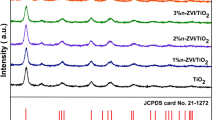Abstract
The oxidant ClO− was generated on an SPR (SnO2-PdO-RuO2-TiO2) anode and used to degrade formaldehyde in aqueous solution. The current efficiency of the production of hypochlorite ion was significantly affected by the concentration of chloride ion, pH and stirring rate. The effect of current density and temperature on the current efficiency for electrogeneration of hypochlorite ion was slight. The maximum anodic current efficiency was 99.3% when 100 C was charged. Increasing the concentration of chloride ion, pH, temperature, stirring rate and the concentration of formaldehyde in the solution and decreasing the current density and charge passed resulted in increased current efficiency of degradation of formaldehye with electrogenerated hypochlorite ion.
Similar content being viewed by others
References
F. W. Pontius, ‘Water Quality and the Treatment’, 4th edn, McGraw-Hill, New York (1990).
J. S. Do and T. C. Chou, J. Appl. Electrochem. 19 (1989) 922.
Idem, ibid., 20 (1990) 978.
Idem, ibid. 22 (1992) 966.
S. Trasatti, ‘Electrodes of Conductive Metallic Oxides’, Part B, Elsevier Scientific, New York (1981) pp. 535–41.
T. Yokoyama and M. Enyo, Electrochim. Acta 15 (1970) 1921.
G. Faita and G. Fiori, J. Appl. Electrochem. 2 (1972) 31.
A. T. Kuhn and C. J. Mortimer, ibid. 2 (1972) 283.
Idem, J. Electrochem. Soc. 120 (1973) 231.
J. E. Bennett, Chem. Eng. Prog. 70 (1974) 60.
D. Galizzioli, F. Tantardini and S. Trasatti, J. Appl. Electrochem. 4 (1974) 57.
T. Arikado, C. Iwakura and H. Tamura, Electrochim. Acta 23 (1978) 9.
V. L. Kubasov, I. A. Ivanter, E. A. Druzhinin and V. B. Vorob'eva, Zhurnal Prikladnoi Khimii 58 (1985) 1900.
J. A. Harrison and A. D. Hermijanto, J. Electroanal. Chem. 225 (1987) 159.
L. R. Czarnetzki and L. J. J. Janssen, J. Appl. Electrochem. 22 (1992) 315.
D. L. Jones, Amer. Dyest. Rep. 61 (1972) 28.
M. Tanaka, Japan Kokai 74 116 858 (1974).
V. B. Busse-Machukas, F.I. Lvovich, E. K. Spasskaya, V. L. Kubasov, A. F. Mazanko, E. A. Druzhinin, A. N. Martynov and L. N. Neilipa, US Patent 4 564 434 (1986).
J. F. Woolley, Brit. Patent 1 433 858 (1974).
M. Kazama and Y. Fujimoto, Jpn. Kokai Tokkyo Koho JP 61 149290 (1986).
J. S. Do and C. P. Chen, J. Electrochem. Soc. 140 (1993) 1632.
J. S. Do and W. C. Yeh, J. ChIChE 25 (1994) 221.
A. P. Altshuller, D. L. Miller and S. F. Sleva, Anal. Chem. 33 (1961) 621.
L. R. Czarnetzki and L. J. J. Janssen, J. Appl. Electrochem. 22 (1992) 315.
R. E. Connick and Y. T. Chia, J. Am. Chem. Soc. 81 (1959) 1280.
N. Ibl and D. Laudolt, J. Electrochem. Soc. 115 (1968) 713.
D. Laudolt and N. Ibl, Electrochem. Acta 15 (1970) 1165.
N. V. Krstajic, M. D. Spasojevic and M. M. Jaksic, J. Molecular Catal. 38 (1986) 81.
Author information
Authors and Affiliations
Rights and permissions
About this article
Cite this article
Do, JS., Yeh, WC. In situ degradation of formaldehyde with electrogenerated hypochlorite ion. J Appl Electrochem 25, 483–489 (1995). https://doi.org/10.1007/BF00260692
Received:
Revised:
Issue Date:
DOI: https://doi.org/10.1007/BF00260692




